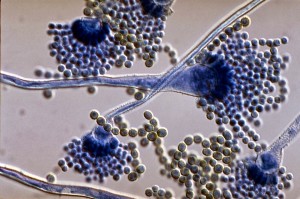 When it comes to allergens, very few can compete with mold. This mighty microscopic organism is a type of fungus that has survived every environmental condition since the dawn of time. While mold thrives in damp, warm and/or dark places, when an organism is this tough, it’s no surprise that it can be found virtually anywhere, any time of year.
When it comes to allergens, very few can compete with mold. This mighty microscopic organism is a type of fungus that has survived every environmental condition since the dawn of time. While mold thrives in damp, warm and/or dark places, when an organism is this tough, it’s no surprise that it can be found virtually anywhere, any time of year.
Like all living things, mold requires food, water, oxygen and an adequate temperature to grow. Yeast is a type of mold that makes bread rise when it reacts with sugar, warm liquid and air. More resilient molds are just as happy with colder and hotter temperatures and food sources including wallpaper, fabrics, wood, dust and decomposing leaves.
Outdoors, an invisible, airborne mold spore can float through on summer breeze and settle in cut grass under a shade tree. Decaying leaves and autumn rains will help it grow and while the mold stays dormant during the winter, even the harshest weather conditions won’t kill it. As temperatures rise and snow melts, mold grows and waits for the next windy day to start the cycle all over again.
Mold Growth Indoors
A similar mold life cycle occurs indoors. The obvious and frequent indoor places to harbor mold include basements, bathrooms and kitchens. But mold can also find a home where flooding or leakage has occurred in roofs, pipes or walls. Even areas around indoor plants can be hospitable for mold. And if mold makes a home in heating and air conditioning ducts, the spores can be spread throughout an entire building very quickly.
Mold problems can develop almost overnight. In an optimum environment, mold growth can occur in just 48 hours. While mold spores are invisible, mold growth can be seen. White, green, blue or even black spots on walls or ceilings may indicate a mold problem.
Health Dangers of Mold
For people who are sensitive to allergens, the invisible, airborne mold spores that are easily inhaled can cause a wide variety of symptoms from nasal stuffiness, eye irritation, wheezing, or skin irritation to more severe symptoms like fever and shortness of breath. For some people, mold can make existing health conditions worse and mold can even be toxic.
While the allergic reactions to mold can be dangerous, eliminating mold can present its own health-related challenges. The harsh chemicals often used to eliminate mold also can also cause allergic reactions or trigger asthma attacks. Most products used to treat mold carry safety cautions and suggest that the user wear goggles and a respirator.
A Safe and Healthy Solution for Mold Control
The Grime Stoppers has a safe and effective solution for mold removal, odor control, green cleaning, and broad-spectrum disinfection. It’s called Vital Oxide and it destroys mold on contact and prevents mold spore germination for up to seven months.
Vital Oxide is an Environmental Protection Agency (EPA) approved sanitizer that is an environmentally friendly alternative to harsh chlorine (bleach) or ammonia cleaners. This odorless product is ideal for hospitals or other health clinics where caution is essential for people who suffer from allergies or asthma. It’s so safe that you can wash your hands with it and it can treat all types of surfaces, including fabric, wood, concrete, and bathroom or ceiling tiles. Vital Oxide penetrates hard and porous surfaces alike, killing mold and airborne pathogens.
Contact The Grime Stoppers to learn more about Vital Oxide and how it can safely and effectively eliminate your mold problem.
